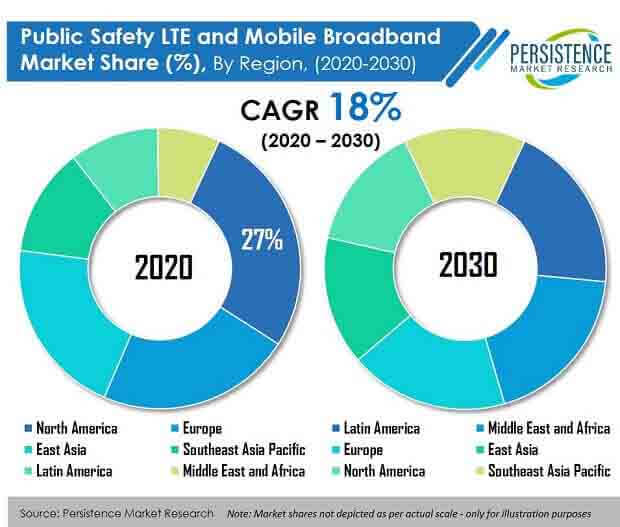Public Safety LTE and Mobile Broadband Market Segmented By Two-way Wireless Communication, Public Safety Broadband Network, Private/Commercial Mobile Data, Device-to-Device Communication Infrastructure and Consultation Services, Integration and Installation Services, Maintenance and Support Services
Industry: IT and Telecommunication
Published Date: October-2020
Format: PPT*, PDF, EXCEL
Delivery Timelines: Contact Sales
Number of Pages: 270
Report ID: PMRREP32041
Today, the world is experiencing a crisis that is likely to change how governments and first responders operate. While concerned authorities do not fully understand how the ongoing COVID-19 pandemic will affect the world in the future, they do know that the establishment of public safety LTE and mobile broadband can enhance mission-critical communication capabilities over the coming years.
September 2001 witnessed a great tragedy in the United States. Loss of life and socio-economic impacts shook the nation, and the inability of first responders to communicate during the emergency was exposed. This led to the implementation of a nationwide public safety LTE and mobile broadband network, FirstNet. In March 2017, the United States federal government opted for AT&T, Inc. to sign a Public-Private Partnership (PPP or 3P) to develop and manage a public safety LTE and mobile broadband network for the country.
As per PMR analysis, the public safety LTE and mobile broadband market size is projected to expand at an impressive CAGR of 18% over the next ten years.
Critical communication has traditionally relied on legacy P25 and TETRA technologies. Cellular communication services have long since evolved to facilitate high bandwidth data connectivity, multimedia calling, and wideband audio. However, first responders and emergency service providers using Land Mobile Radio (LMR) have not prospered at the same rate. Even cellular communication technologies are not ready to offer essential mission-critical communication capabilities.
This inability makes public safety LTE and mobile broadband a much more viable alternative. This is supporting mission-critical communication technologies such as Push-To-Talk (PTT) and peer-to-peer operations, which is aiding the growth of the global public safety LTE and mobile broadband market.
Frequency spectrum is a very limited resource, and requires to be used considerately and efficiently. Every frequency range has a unique band designation, and every frequency range is associated with a specific function. As per the radio norms and regulations legislated by the International Telecommunications Union (ITU), available frequency range spectrum is conjointly shared by different governments, militaries, and civil end users, and LTE frequency spectrum is divided into unpaired and paired bands. Scarcity in available frequency spectrum is slowing down the implementation of public safety LTE and mobile broadband, globally.
Further, dedicated LTE frequency spectrum and void of previous service is a requirement for public safety models. Dedicated LTE demands heavy investments and lengthy planning cycles. Governments incur significant initial expenditure while building and maintaining dedicated public safety LTE and mobile broadband network infrastructure. This is another challenge restricting the growth of the global public safety LTE and mobile broadband market.

Among all the regional markets, the public safety LTE and mobile broadband market in Middle East and Africa is projected to record the highest CAGR of approximately 30%, over the forecast period. This strong growth rate can be attributed to high demand emanating for advanced cellular and LMR communication infrastructure from MEA economies such as Israel and Turkey. Currently, North America leads the global public safety LTE and mobile broadband market share, followed by the market in Europe.
This dominance can be owed to high focus on implementing a nationwide network infrastructure to tackle unforeseen environmental threats and challenges in the United States.
Stringent lockdowns and curfews have been implemented by governments across the globe due to the COVID-19 outbreak. Teams of authorities and stakeholders tackling the spread of COVID-19 primarily comprise first responders and emergency assistance providers such as paramedics, police officials, and healthcare experts and professionals. These professionals demand high network capacities and efficient radio communication technologies to perform effectively.
Further, governments across the globe are making it their goal to monitor the spread of COVID-19 in real time. Such applications and use cases are promoting the implementation of public safety LTE and mobile broadband infrastructure on a global scale.
Adoption of public safety LTE and mobile broadband is primarily driven by focus of national governments on implementing a nationwide network coverage that helps tackle terrorist attacks, minimize or prevent loss of life and damage to property due to natural calamities, and also minimize socio-economic impacts of cyber-attacks. The global public safety LTE and mobile broadband market is projected to be valued at US$ 70 Bn by the end of the forecast period of 2020 to 2030.
PMR’s research study on the global public safety LTE and mobile broadband market offers a detailed market segmentation, wherein, key segments have been discussed in detail. The segmentation of the public safety LTE and mobile broadband market has been offered on the basis of solution, end use, and region. Every segment has been analyzed in detail and data pertaining to the growth of each segment has been included in the study.
| Attribute | Details |
|---|---|
|
By Solution |
|
|
By End Use |
|
|
By Region |
|
To know more about delivery timeline for this report Contact Sales
